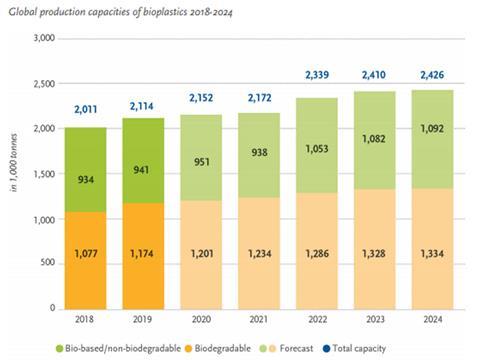
The results of the European Bioplastics’ annual market data update, presented at the 14th European Bioplastics Conference in Berlin, reportedly confirm the dynamic growth of the global bioplastics industry. Packaging remains the largest field of application for bioplastics with almost 53 percent (1.14 million tonnes) of the total bioplastics market in 2019.
“In an increasingly eco-conscious environment, the global market for bioplastics is predicted to grow by more than 15 percent over the next five years,“ says Hasso von Pogrell, Managing Director of European Bioplastics. “This trend is possible thanks to steadily increasing demand for sustainable products from both consumers and brands alike and the continuous efforts of the bioplastics industry to develop innovative materials with improved properties and new functionalities.”
According to the report, global bioplastics production capacity is set to increase from around 2.1 million tonnes in 2019 to 2.4 million tonnes in 2024. Innovative biopolymers such as PP (polypropylene) and PHAs (polyhydroxyalkanoates) are reportedly driving this growth. These polyesters are apparently bio-based, biodegradable, and feature a wide array of physical and mechanical properties. Production capacities of PP are set to almost sextuple by 2024, due, the report says, to the widespread application of PP in a wide range of sectors. The report goes on to argue that high-performance PP grades are an ideal replacement for several conventional fossil-based plastics, especially PE.
Bio-based, non-biodegradable plastics, including the drop-in solutions bio-based PE (polyethylene) and bio-based PET (polyethylene terephthalate), as well as bio-based PA (polyamides), currently make up for around 44 percent (almost 1 million tonnes) of the global bioplastics production capacities. The production of bio-based PE is predicted to continue to grow as new capacities are planned to come online in Europe in the coming years. Intentions to increase production capacities for bio-based PET, however, have not been realised nearly at the rate predicted in previous years, but actually declined over the years. Instead, the focus has shifted to the development of PEF (polyethylene furanoate), a new polymer that is expected to enter the market in 2023. PEF has been described as comparable to PET, but is reportedly fully bio-based and features barrier and thermal properties that make it a suitable material for beverage bottles.
With a view to regional capacity development, Asia remains a major production hub with over 45 percent of bioplastics currently being produced there. Presently, one-fifth of the production capacity is located in Europe. This share is predicted to grow to up to 30 percent by 2024.
The land used to grow the renewable feedstock for the production of bioplastics is estimated to be 0.7 million hectares in 2019 and reportedly continues to account for around 0.02 percent of the global agricultural area of 4.8 billion hectares. Despite the market growth predicted in the next five years, the report states that the land use share for bioplastics will remain at this level.
The full report can be read here.















